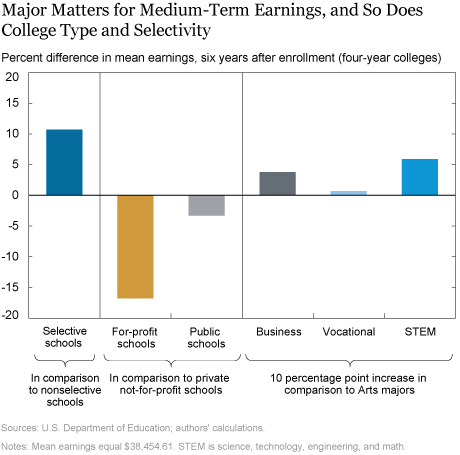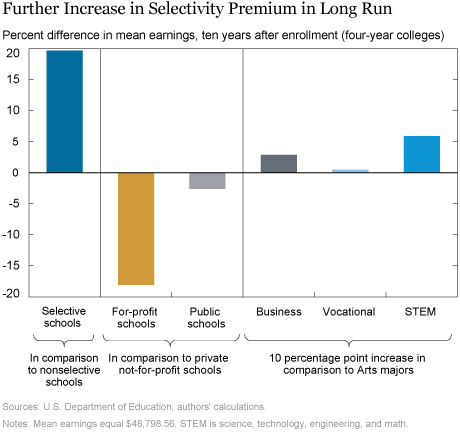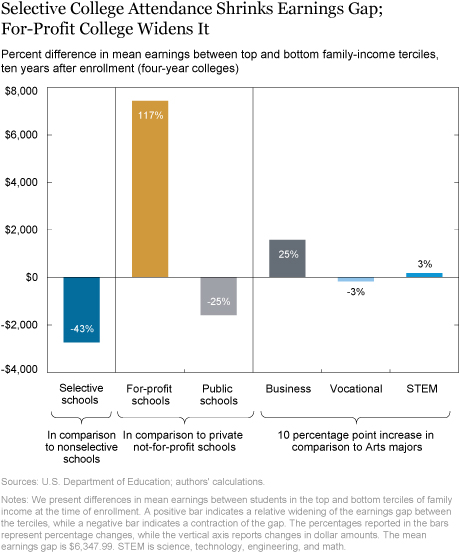Amid dialogue about the soaring student loan burden, questions arise about how educational characteristics (school type, selectivity, and major) affect disparities in post-college labor market outcomes. In this post, we specifically explore the impact of such school and major choices on employment, earnings, and upward economic mobility. Insight into determinants of economic disparity is key for understanding long-term consumption and inequality patterns. In addition, this gives us a window into factors that could be used to ameliorate income inequality and promote economic mobility.
We hope to answer the following questions:
- Do school and major choice significantly affect differences in employment and earnings?
- Do these differences persist in the long term?
- Do certain educational background characteristics promote upward economic mobility more than others?
To answer these questions, we use a data set that matches earnings and employment data of college cohorts with corresponding college-cohort characteristics, college characteristics, and enrollment, obtained from the U.S. Department of Education. We analyze labor market outcomes data for fall freshman entry cohorts in the 1997-2007 period. Labor market outcomes include earnings and employment, measured in the medium term (six years after enrollment) and the long term (ten years after enrollment), with earnings conditional on employment. Our selectivity measure comes from Barron’s Profiles of American Colleges (2001), which ranks schools based on their acceptance rates, students’ median entrance exam scores (on the SAT and ACT), the grade point averages for their freshman classes, and the percentage of freshman ranking in the top of their high school graduating classes. For simplicity, we classify four-year colleges in the top three of Barron’s six tiers as “selective” and the rest as “nonselective.”
After controlling for invariant characteristics of counties where the colleges are located, invariant characteristics of cohorts, and time-variant characteristics of cohorts (such as cohort size, racial composition, gender composition, family income, and parental education), we analyze the effect of college choice (two-year versus four-year; public versus private not-for-profit and private for-profit; and selective versus nonselective) and major composition (calculated as the percentage in “Arts” [arts and humanities], “Business,” “STEM” [science, technology, engineering, and math], and “Vocational” fields) on labor market outcomes and economic mobility (defined below).
First, we explore whether college choice and major choice affect medium-term earnings and employment measured six years after enrollment. For four-year colleges, we find that college type and selectivity strikingly matter, as does major (see the chart below). For enrollees who attend selective colleges, we find an earnings premium of 11 percent compared with similar students (along the dimensions defined above) who attend nonselective colleges. By contrast, for-profit college attendance leads to 17 percent lower earnings relative to attendance at private not-for-profit four-year colleges. The right panel in the chart casts light on the returns to various majors relative to Arts and depicts the percentage change in mean earnings of a cohort in a school if the share of a certain major in that cohort goes up by 10 percentage points. The chart shows that STEM majors have the highest earnings premium followed by Business majors. If a school cohort increases its share of STEM majors (relative to Arts majors) by 10 percentage points, there is a 6 percent increase in that cohort’s earnings six years after enrollment. These findings are qualitatively similar for two-year colleges.
While this data is not charted here, we find that the employment effects are relatively modest in comparison to the earnings effects. Selective college enrollment leads to only 1 percent higher employment than nonselective college enrollment, while for-profit enrollees have a 4 percent lower probability of employment relative to their counterparts in private not-for-profit colleges. The employment and earnings results collectively imply a markedly higher job quality for selective college and not-for-profit enrollees.
For long-term earnings measured ten years after enrollment, we find that college-type effects become more pronounced, while major-choice effects remain similar (see the chart below). Attendees of selective colleges find themselves with a 20 percent premium in earnings compared with nonselective college students. For-profit attendees experience 18 percent lower earnings than students enrolled at private not-for-profit colleges. Meanwhile, a 10 percentage point increase in a college cohort’s share of STEM majors (relative to Arts majors) gives a 6 percent boost to its students’ average earnings, while a 10 percentage point increase in a school’s share of Business majors (relative to Arts majors) provides a 3 percent long-term earnings premium. In contrast, employment probabilities remain similar in the long run for these comparison groups. This indicates that the quality of jobs, rather than the probability of employment, is more relevant for the broadening of the earnings distribution across individuals.
Next, we consider economic mobility. Following prior work, we define economic mobility as the phenomenon by which individuals move up or down the income distribution over time. Our chart below presents differences in mean earnings six years after enrollment between students in the top and bottom terciles of family income at the time of enrollment in a four-year institution. We continue to include the various covariates and invariant characteristics in our regression as described above.
The average earnings gap between enrollees in the top and bottom terciles in our sample was $6,348. We find that for-profit college attendance widened income disparities in our data, increasing the earnings gap by $7,428 (+117 percent), compared with private not-for-profit college. In contrast, four-year public college serves as an equalizer by decreasing the earnings gap by $1,584 (-25%) compared with four-year not-for-profit college. In addition, selective college attendance decreases the earnings gap by $2,736 (-43%) relative to nonselective college attendance. A 10 percentage point increase in Business majors and STEM majors relative to Arts majors exacerbates the gap by $1,586 (+25%) and $181 (+3%) , respectively, while a 10 percentage point increase in Vocational majors relative to Arts majors decreases the disparity by $170 (-3%).
In the long run, however, the inequality penalties for for-profit schools decrease in intensity, while the equality premium for public school increases. While patterns for other majors are approximately the same in the medium term as in the long run, a STEM major becomes more of an equalizer.
Earnings and employment outcomes are clearly heterogeneous across college and major choice. We see that these choices matter much more for earnings than employment, which suggests that school and major choice play a large role in job quality. Overall, we find large positive premiums to selective college attendance and choice of a STEM major, and find large penalties for for-profit college attendance. In the long run, premiums and penalties related to college type further accentuate, while premiums to major remain similar to what they are in the medium term. Recent trends in college enrollment, which show marked decrease in for-profit enrollment, imply that overall earnings of college graduates should improve in the medium and long terms due to this factor. In terms of economic mobility, we find that selective colleges are particularly equalizing (conditional on access). Further, we find that attendance at for-profit colleges has led to wider income gaps subsequently, despite catering overwhelmingly to low-income students. These findings have important implications for policy, specifically for “gainful employment” regulations, which stipulate that educational programs must offer worthwhile preparation in a recognized occupation to be eligible for student-assistance funding under the Higher Education Act, and the recent start of a rollback of these provisions. They also highlight the importance of the availability of information about college and major choices since these choices can matter not only for labor market outcomes but also in affecting income inequalities in the medium to long term.
Disclaimer
The views expressed in this post are those of the authors and do not necessarily reflect the position of the Federal Reserve Bank of New York or the Federal Reserve System. Any errors or omissions are the responsibility of the authors.
 Rajashri Chakrabarti is a senior economist in the Federal Reserve Bank of New York’s Research and Statistics Group.
Rajashri Chakrabarti is a senior economist in the Federal Reserve Bank of New York’s Research and Statistics Group.

Michelle Jiang is a former senior research analyst in the Federal Reserve Bank of New York’s Research and Statistics Group.
How to cite this blog post:
Rajashri Chakrabarti and Michelle Jiang, “Education’s Role in Earnings, Employment, and Economic Mobility,” Federal Reserve Bank of New York Liberty Street Economics (blog), September 5, 2018, http://libertystreeteconomics.newyorkfed.org/2018/09/educations-role-in-earnings-employment-and-economic-mobility.html.














 RSS Feed
RSS Feed Follow Liberty Street Economics
Follow Liberty Street Economics